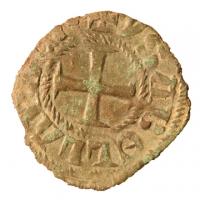MONEY IN 14TH CENTURY CONSTANTINOPLE
About the research project

Billon tournois from the Thasos excavations of the French school at Athens. Image courtesy of Thasos Archaeological Museum.
In the centuries before its final demise in 1453, the Byzantine Empire experienced momentous geo-strategic, political and socio-economic changes. This project aims to record and study coin production and coin finds in the area around Constantinople and
thereby explore the monetary dimension to the collapse of the Byzantine empire, particularly during the long 14th century.
The focus of the project is the Byzantine Empire, as much as the emerging Ottoman polity which eventually displaced it, the different Genoese entities in the northern Aegean and Pera, and more marginally the Second Bulgarian Empire. Underlying the political
mutations are the populations at large and the commercial integration of the entire area. The monetary data reveal, amongst other things, the effectiveness of economic and fiscal policies of the different polities, the standard of living of various
populations and their participation in commercial activities, and the impact of major military disruptions. In order to gain a comprehensive picture of the monetary situation, the coin issues of the area and period need to be investigated and a catalogue
of local finds established.
Research aims
This project uses the analysis of coins and coin finds, considering all metals, all denominations and coins from all contexts (hoards, single finds, and collections) to answer the following research questions:
- What can the coins and coin finds of the 14th century tell us about political power and political/military intent in the area?
- What do they reveal about the economy of the Byzantine Empire and the surrounding polities? What can they tell us about standards of living, and about trading activities?
- How do the balances of payments between the local Byzantine, Ottoman, Genoese and Bulgarian spheres, and with the surrounding areas and the Latin West, indicate shifts in power and influence?
- How can the quality of the coins and their finds help us to map the decline and collapse of the Byzantine Empire and the parallel ascendancy of other powers?
This project is being carried out in three phases. The first phase is the recording and analysis of a number of coin finds in specific museums in Greece and Turkey. The second phase is the completion of this recording activity in Turkish and
adjacent Bulgarian museums. The policy is to publish specific coins in context gradually. The established monetary data, in the third phase, are drawn together more comprehensively and confronted with other forms of historical evidence.
Project team
Dr Julian Baker, Ashmolean Museum, University of Oxford
Research Connections
Archaeological Museum Istanbul, Turkey
Archaeological Museum Edirne, Turkey
Archaeological Museum Komotini, Greece
Archaeological Museum Thasos, Greece
Archaeological Museum Samothrace, Greece
Byzantine Museum Didymoteicho, Greece
Publications
Baker, J. (2014). ‘Coin Circulation in Late Medieval Thrace According to the Evidence from Edirne Archaeological Museum’. Numismatic Chronicle 174: 245–56.
Baker, J. (2013). ‘Coins from the late medieval period from excavations in Ainos (Enez) in Thrace’. Numismatic Chronicle 173: 215–27.




